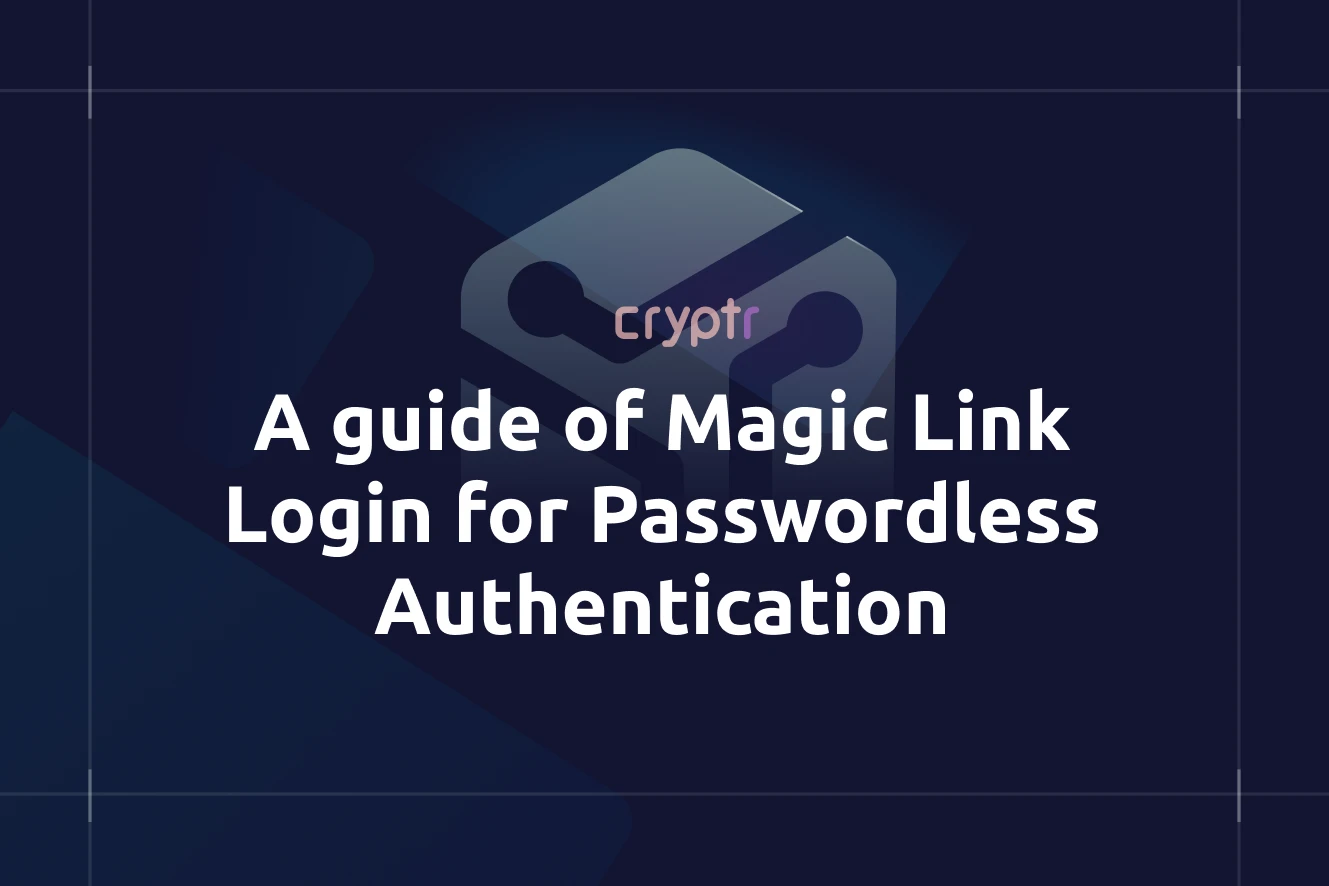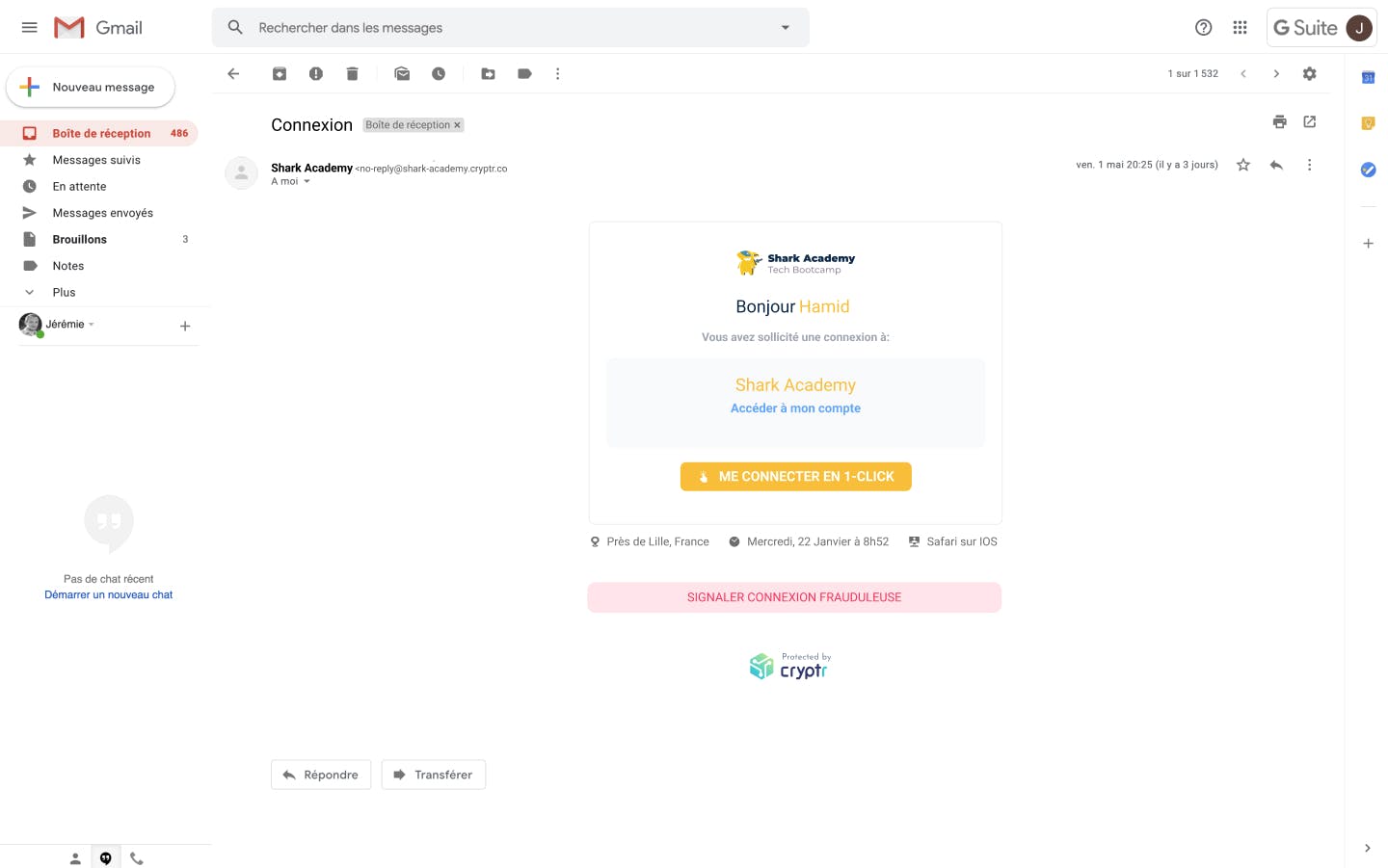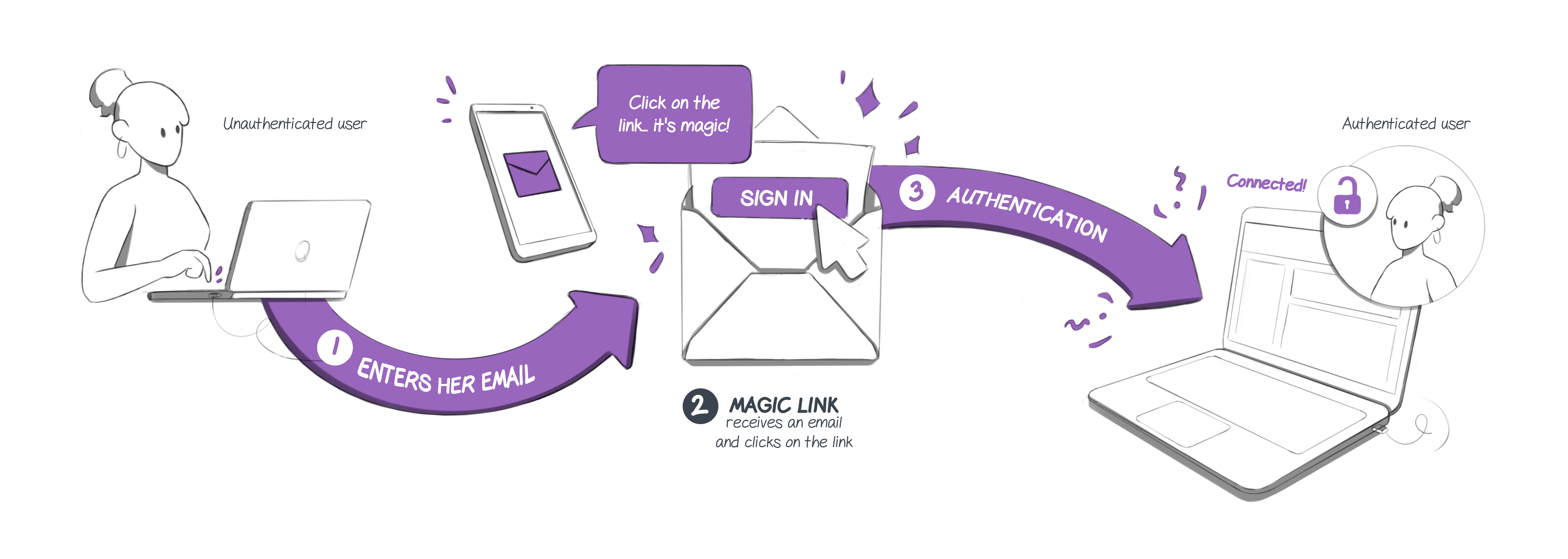A guide of Magic Link Login for Passwordless Authentication
by Alexandre Dedourges, DevSec

This article was created in collaboration with Jérémie Flandrin, CTO at Cryptr.
In 2018, a study by Dashlane and Virginia Tech found that the average user managed over 150 online accounts, expected to reach 300 by 2022. Memorizing unique passwords for each account is impractical, as 52% of people reuse or slightly modify the same password across platforms. Magic links offer a secure authentication method that eliminates the need to memorize and update passwords, making the login process easier and faster. Since a magic link is a one-time use link that expires, this form of authentication creates a simple yet secure authentication flow without traditional password risks.
Magic links also address email security risks by minimizing the dependency on individual websites’ security. Verizon data shows over 2,000 security breaches in 2016, compromising billions of credentials. With reused passwords, a single breach can affect multiple accounts, but magic links prevent this by requiring access only to the user’s email.
Poor password choices are a top authentication factor vulnerability. According to the OWASP rankings, weak authentication was the #2 risk in 2017 and #7 in 2021, so implementing magic links reduces these vulnerabilities by eliminating passwords entirely.
For companies, authentication protocols are costly; a Forrester study found organizations spend over €890K ($1M) on password support, but magic links can also reduce this, since no storage or encryption is required.

Magic links also improve user experience by reducing login friction, making users more inclined to sign up. A study by Oxford University and Mastercard showed over one-third of shopping carts are abandoned due to forgotten passwords.
Magic links are versatile and do not rely on additional devices like biometric authentication or device authentication, where phones or USB keys are needed. Although magic links can be paired with other methods for heightened security, they are a standalone, secure authentication method that simplifies login.
What is Magic Link Authentication?
How Does Magic Link Authentication Work, step by step?

User Request: A user enters their email address (or phone number) in the login form and requests to log in.
Link Generation: The application generates a secure, unique link (the "magic link") associated with that email or user. This link usually includes a time-limited, randomly generated token.
Link Delivery: The application sends this link to the provided email (or phone number) as part of a message, often saying, "Click here to log in."
User Clicks the Link: When the user clicks on the link, they’re redirected back to the application, where the server validates the token.
Token Validation: If the token is valid, hasn't expired, and matches the user's request, the server authenticates the user.
Session Creation: Once authenticated, the server generates a session or JWT token for the user, allowing them to access the application without needing to reauthenticate immediately.
What Makes Magic Links Different from Other Methods?
No Password Requirement
Magic Links: Users log in using a one-time link sent to their email or SMS, removing the need for passwords.
Traditional Methods: Require users to enter usernames and passwords, which can lead to forgotten credentials.
User Experience
Magic Links: Provide a seamless experience with just one click to log in.
Traditional Methods: Involve multiple steps, which can frustrate users.
Security Posture
Magic Links: Reduce the risk of password-related attacks but depend on the security of email or messaging systems.
Traditional Methods: Are vulnerable to issues stemming from weak or reused passwords.
Token-Based Authentication
Magic Links: Use time-sensitive tokens that expire if not used quickly, ensuring one-time use.
Traditional Methods: Often rely on persistent tokens or sessions, which may be more susceptible to replay attacks.
Account Recovery
Magic Links: Allow users to regain access easily by sending a new link without needing a password reset.
Traditional Methods: Require a cumbersome password reset process.
Magic link vs OTP
Magic links can replace one-time passwords (OTPs) by providing a seamless login experience without requiring users to enter a numeric code. Instead of receiving a separate OTP, users simply click a link sent to their email or phone, which authenticates them instantly. This approach reduces friction and minimizes the risk of errors associated with manually entering OTPs.
Magic links enhance user convenience and security but require strong safeguards against risks associated with email or messaging systems. In contrast, traditional methods are familiar but can lead to password-related issues.
What are the Benefits of Using Magic Links?
Enhancing Security with Magic Links
The security of magic link authentication relies on several key factors that make it a robust alternative to traditional password-based methods. First and foremost, it eliminates passwords altogether, reducing the risks associated with weak, reused, or stolen credentials, as there is nothing to compromise. Magic links, typically sent via secure channels like email or SMS, are designed for one-time use and usually expire after a short period, limiting the window of opportunity for potential attackers. Additionally, this method requires users to have access to the email address or phone number associated with their account, adding an extra verification step. Magic link authentication is also less vulnerable to phishing attacks since users do not enter their credentials. By potentially integrating additional security measures, such as multi-factor authentication, and allowing for the tracking of link usage, this method provides a dynamic and secure way to manage user access while enhancing the overall user experience.
Improving User Experience with Passwordless Login
Passwordless login significantly enhances user experience by addressing common frustrations associated with traditional password-based authentication. By eliminating the need to remember complex passwords, users enjoy a simplified and faster login process, allowing them to access their accounts almost instantly through methods like magic links or biometrics. This reduction in password fatigue minimizes frustration, leading to higher satisfaction and lower abandonment rates. Additionally, users feel more secure with passwordless methods, as they are less vulnerable to threats like phishing and credential theft, fostering a positive experience. The convenience of seamless access across multiple devices, coupled with simplified account recovery, further contributes to an intuitive and user-friendly interface. Ultimately, passwordless login encourages greater engagement and retention, as users are more likely to adopt applications that offer quick and convenient access.
Reducing Password Fatigue for Users
Magic link authentication effectively reduces password fatigue for users by eliminating the need to remember complex passwords, significantly decreasing the cognitive load associated with managing multiple credentials. With a simplified login process that allows users to access their accounts with a single click on a link sent to their email or phone, the overall experience becomes faster and more straightforward. Additionally, magic links often enable longer session durations, reducing the frequency of logins and minimizing password reset requests since users are less likely to forget credentials. This approach alleviates anxiety about managing passwords and enhances confidence in security. The convenience of accessing accounts seamlessly across devices further encourages user engagement, making it easier for users to interact with applications and services without encountering the typical barriers associated with traditional password systems.
Are There Any Issues with Magic Link Authentication?
Potential Security Concerns with Email Magic Links
Email magic links provide convenient authentication but come with security concerns. If a user's email account is compromised, attackers can access linked accounts. Phishing attacks may trick users into clicking on malicious links that mimic legitimate messages. Additionally, links can be intercepted on unsecured networks, and if not designed for one-time use, old links may be reused by attackers. Users may also be unaware of the importance of securing their email accounts or recognizing phishing attempts. Inadequate server validation of links and access on shared devices can further increase the risk of unauthorized access. Educating users and implementing strong security measures are essential to mitigate these threats.
Handling Email Delivery Challenges
Handling email delivery challenges is crucial for ensuring the effectiveness of authentication methods like magic links. Common issues include emails being marked as spam or delayed delivery, which can prevent users from receiving their links. To improve deliverability, organizations should use verified sending domains and implement SPF, DKIM, and DMARC protocols. User-specific filters may also redirect magic link emails, so encouraging users to check their spam folders and whitelist sending addresses is important. Additionally, implementing email validation can help prevent errors in user input. Optimizing server performance and monitoring email queues can reduce delivery delays, while rate limiting can help avoid triggering restrictions from email providers. Finally, allowing users to easily request new magic links and implementing reminders can address the problem of non-responsive users. By taking these measures, organizations can enhance the reliability and user experience of their email-based authentication methods.
Addressing User Authentication Problems
Magic links effectively address user authentication problems by providing a convenient and secure alternative to traditional password-based systems. By eliminating the need for passwords, they reduce the cognitive load on users and eliminate frustrations associated with remembering or resetting complex credentials. The streamlined login process allows users to access their accounts with a single click on a magic link sent via email or SMS, speeding up authentication and enhancing user experience. Additionally, magic links decrease vulnerability to phishing attacks since users do not enter passwords, and they simplify account access, reducing recovery challenges. With time-sensitive links that expire after a short period, the risk of unauthorized access is minimized. Magic links also offer seamless access across devices, empowering users to manage their access easily. This user-friendly approach encourages greater engagement with applications by lowering barriers to entry and promoting ongoing interaction.
Transforming User Experience with the Cryptr Magic Link Solution
Try Cryptr's authentication with magic links as a robust passwordless authentication method for enhancing user login experiences. By implementing this authentication system, you can streamline the authentication process, allowing users to receive a magic link in their email and complete the authentication by simply clicking on the link. This method significantly improves account security since magic links rely on the security of the user’s email address and the associated email provider. Additionally, since magic links may serve as a one-time form of authentication, they can help mitigate security risks commonly associated with traditional passwords and even complement two-factor authentication strategies. With just a few lines of code, you can enable users to go passwordless and access their accounts securely while ensuring that the magic link URL expires after a short time, further enhancing the authentication experience. For a detailed implementation guide, please follow the instructions provided by Cryptr to request a magic link and ensure that your users can easily access their email account for a smooth login.
Add enterprise SSO for free
Cryptr simplifies user management for your business: quick setup, guaranteed security, and multiple free features. With robust authentication and easy, fast configuration, we meet businesses' security needs hassle-free.